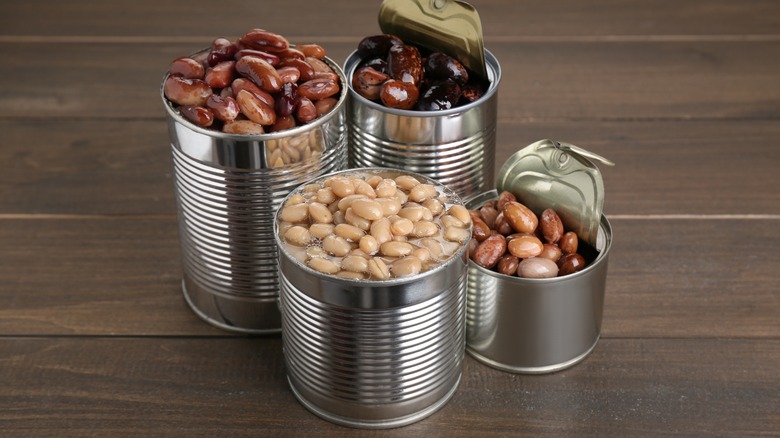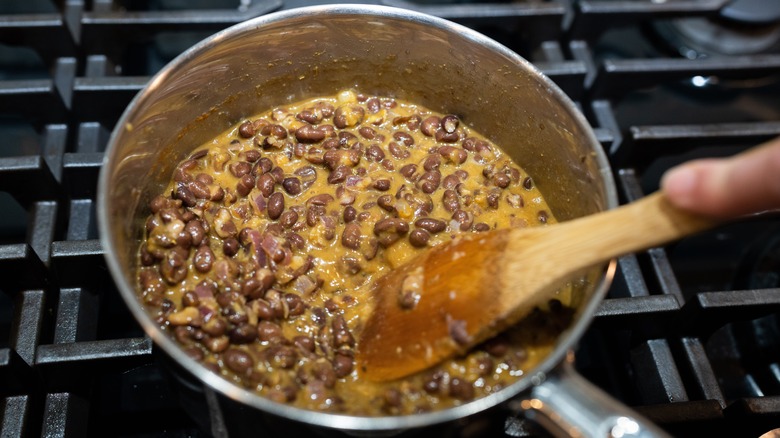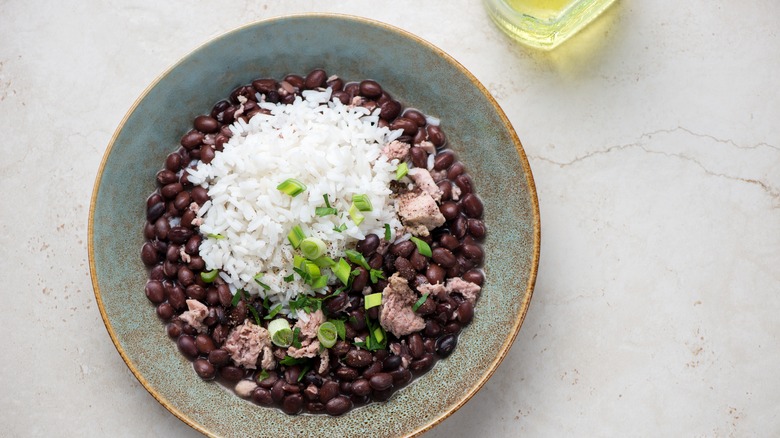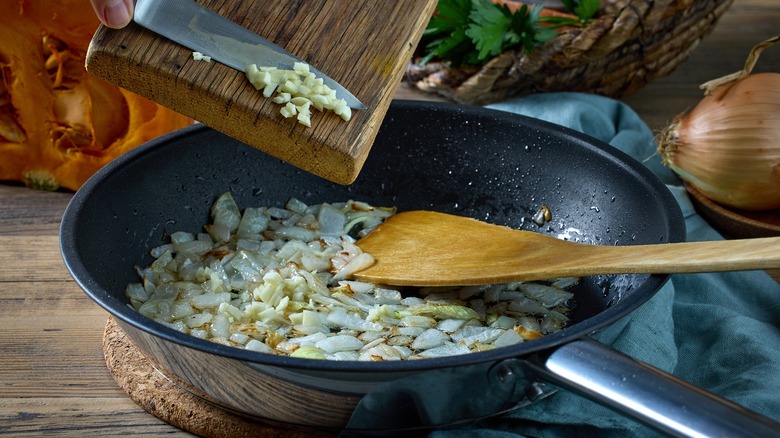The Absolute Simplest Way To Make Canned Beans Taste Homemade
The instructions for canned beans are generally pretty simple: Dump the contents into a pot or pan and heat. Of course, the results can be equally generic. Canned beans taste like, well, beans and little else. The alternative is making beans and bean soups from scratch, which can take time: Soaking, rinsing, and slow-cooking in a Dutch oven alongside a host of other prepared ingredients may take hours before they're ready to enjoy. Surely, there must be an easier way to get that homemade taste from a can.
In fact, by adding a few well-placed ingredients — onions, spices, peppers, meats, herbs — from your cupboard and fridge or pantry, it's easy to dress up those drab legumes. We've already written about specific ingredients that can upgrade canned beans, but bean varieties are not all the same. The flavor and texture of navy beans versus black beans are distinct enough that it's worth fine-tuning what you toss in the pot with them.
Combining beans with specific, easy-to-find fresh veggies, proteins, and spices can quickly convert a bland canned product into an exciting side or main dish with a minimal amount of added kitchen time. Besides improving the taste and complexity of the beans, it's rewarding when someone asks, "Are these homemade?"
How to prepare canned beans
The great thing about improving on canned beans is that often you can do it with whatever's already sitting in your fridge or pantry: Dice up an onion or leftover cooked pork chop, saute some mushrooms, sprinkle some oregano, or dash hot sauce in at the last minute. If you frequently cook with a certain set of spices or a little chicken stock, you can customize the same beans to complement whatever you're preparing for the rest of the meal. Likewise, you can make each bean dish distinctly different from the others by changing up what goes into the pot.
There are three primary points in the cooking process where adding more ingredients to a can of beans impacts the final product. Prior to adding the beans, drizzle a little oil in the bottom of the pot or pan, then toss in ingredients like onions, garlic, leftover chicken, diced bell peppers, or any other goodies you'd give some fry time to if you were making an omelet or pasta sauce.
After you've added the beans, you can jazz them up with pepper, paprika, and other sturdy spices (you usually won't need to add any extra salt — doing so is a totally avoidable mistake). When everything has warmed up, finish with herbs, green onions, pre-cooked veggies, and other heat-sensitive ingredients, cooking for a few minutes more to marry the flavors. This is also a perfect point to add dashes of your favorite sauces or vinegar.
The best ingredients to add to different kinds of beans
Of course the best ingredients are the ones you like, and the ones you have on hand (unless you're a whiz at planning menus that involve canned foods). But there are a few combos that take advantage of each bean's unique character.
For navy beans, saute white onion and garlic, then add a little chopped celery and diced ham or bacon before adding the legumes. If you have extra chicken stock on hand, throw in a cup and simmer for an easy soup. Cannellini beans, meanwhile, are heartier and so full of flavor that it doesn't take much to punch them up. However, if you have some diced peppers or veggies on hand (think carrots and potatoes), you can add a little cumin and curry powder for a creative riff.
If you have pinto beans, it's easy to use an entire can to make quick refried beans: Just heat some oil in a pan and saute chopped onion and jalapeño or Serrano chiles. Mash the beans or blend them to a creamy consistency. Add them to the pan with garlic and seasonings, and stir constantly. Top with shredded cheese if desired.
Black beans are a staple in Caribbean cooking. Cuban-style black beans feature onion, garlic, and green bell pepper. Use a sofrito seasoning to spice it up, and squeeze a bit of lime or add a dash of apple cider vinegar to finish things off and layer over or alongside rice.
Four ingredients that will give canned beans a homemade taste
Okay, so you don't know which cans are hiding in the back of the cupboard, and you only have a couple of half-used veggies in the fridge. No problem! Keep these ingredients on hand, and you can turn any can of beans into something tasty faster.
Even a remnant ring or two of onion or a clove of garlic can be chopped and sauteed with a little seasoning (consider sesame oil for an additional flavor boost). Adding whatever leftover meat is sitting in the fridge (think shredded rotisserie chicken, pre-cooked bacon, or a bit of diced steak) before you add the beans adds a bit of heft. Get creative with seasonings: In addition to pepper, oregano, or smoked paprika, consider trying some of the spice blends that rarely get used (just keep in mind that many contain additional salt), or pungent savory veggies and herbs like fennel or dill. And finally, consider adding other beans! There's a reason three-bean salad has remained popular for decades.
The beauty of canned beans is they're a versatile ingredient, whether on their own or in other dishes. Take advantage of their flexibility, and you'll be stocking up the pantry on your next grocery trip.



